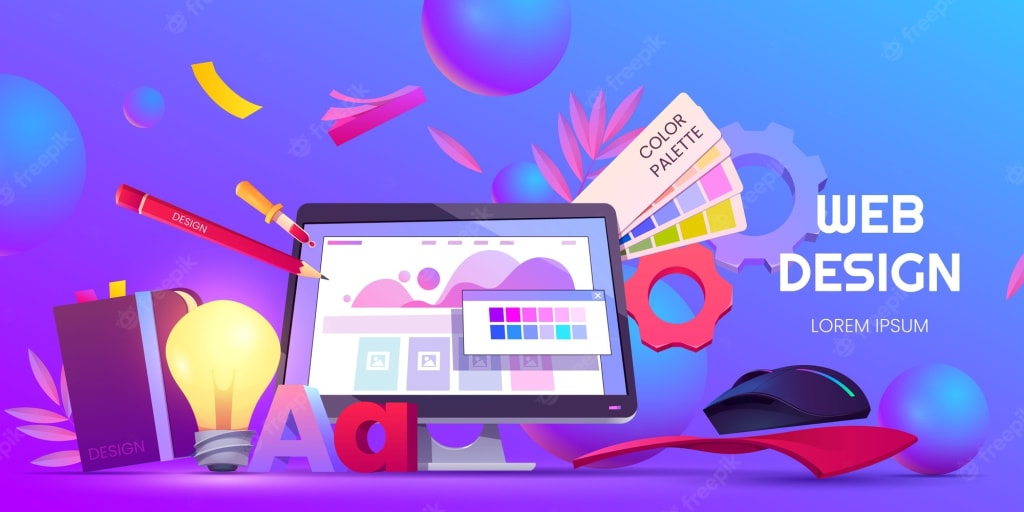News
Web Design: User-Friendly Experiences

Web design is the art and science of building aesthetically pleasing, useful, and user-friendly websites. Effective web design is essential for individuals and businesses to build a solid online presence, interact with visitors, and accomplish their objectives in an increasingly digital environment. This article examines the fundamentals of web design, what makes a website effective, and the most recent developments in the field.
The Importance of Web Design
A well-designed website acts as a company’s digital face, significantly influencing how users perceive and engage with it. Effective site design not only promotes conversions and increases accessibility but also plays a crucial role in enhancing user experience (UX). It involves the seamless integration of usability and aesthetics to create a website that is visually appealing, practical, and easy to navigate, fostering positive user engagement.
User Interface (UI) Design and User Experience (UX)
Web design is incomplete without the crucial components of UX and UI design. UX is dedicated to ensuring that a user’s entire interaction with a website is not just easy to use but also effective and enjoyable. On the other hand, UI design works with the website’s visual components and layout to create a visually appealing interface that significantly enhances user engagement. These design principles are not just important, but they are the backbone of a user-friendly website.
Critical Principles of UX Design
Effective UX design is based on several fundamental principles:
- Simplicity: Avoid clutter and ensure that the website is easy to navigate.
- Consistency: Maintain the same look and feel across all design elements such as fonts, colors, and button styles across the site.
- Accessibility: Makesure the website is accessible to all users, including those with disabilities.
- Feedback: Feedback users through visual cues or notifications, confirming their actions.
Critical Principles of UI Design
UI design principles focus on creating a visually cohesive and engaging interface:
- Visual Hierarchy: Arrange elements to first guide users’ attention to important information.
- Contrast: Use sizes and contrasting colors to make elements stand out.
- Alignment: Align elements consistently to create a structured and organized layout.
- Whitespace: Utilize whitespace effectively to avoid clutter and enhance readability.
Elements of a Successful Web Design

web design
A website’s performance and content are just as important as its design and functionality when it comes to its overall success.
Responsive Design
Responsive design is now essential due to the growing use of mobile devices. A responsive website ensures that visitors can interact with it seamlessly, regardless of the device they use, by customizing its layout and content to fit various screen sizes. This not only broadens the website’s reach but also significantly improves its usability, making it more inclusive and accessible to a diverse audience.
Navigation
An easy-to-use navigation system is essential for a satisfying user experience. Visitors may quickly and easily discover the necessary information using a well-organized navigation menu. This entails giving content logical organization, employing informative labeling, and giving more considerable website search capabilities.
Importance of Navigation in Web Design
Improved navigation can lengthen users’ stays on a website and lower bounce rates, eventually boosting engagement and conversions. It is also important for SEO because search engines like websites that have straightforward navigation and are well-organized.
Content in web Design
One essential element of web design is content. Relevant, high-quality content engages users, fosters trust, and increases conversions. Written material, pictures, videos, and interactive components are all included in this. Maintaining user engagement requires ensuring the material is aesthetically appealing, easily readable, and well-organized.
Visual Content
Images and videos are examples of visual material that can improve user engagement and communicate information more successfully than text alone. Use eye-catching images that bolster the website’s objectives and complement the brand’s identity. The website can also benefit from the addition of infographics, animations, and other interactive components.
Trends in Web Design
The subject of web design is constantly changing due to new trends and technological advancements. Keeping up with current trends can help develop websites that are competitive, interesting, and modern.
Minimalism
Minimalism emphasizes simplicity and functionality by removing extraneous components to concentrate on the most important features and content. This design style improves usability, reduces loading times, and produces a sleek, contemporary appearance.
Dark Mode
The aesthetic appeal and potential of dark mode have made it popular. benefits, such as reducing eye strain in low-light environments. A dark mode option can enhance user experience and cater to user preferences.
Microinteractions
Microinteractions are tiny, understated animations or design components that give users feedback and improve their experience. Button animations, hover effects, and loading indicators are a few examples. These exchanges provide the website with an additional level of engagement and interactivity.
Voice User Interface (VUI)
Voice assistants like Alexa and Siri have become popular, leading to an increase in their usage. it more common to incorporate VUI into web design. As more people choose voice interactions, voice-activated search and navigation can increase accessibility and offer a hands-free browsing experience.
Summary
Aesthetics, functionality, and user experience are all combined in the dynamic and varied field of web design. Designers may produce websites that captivate and engage people by comprehending and implementing UX and UI design fundamentals, adding necessary components like responsive design and high-quality content, and keeping up with recent developments. Effective web design is essential for building a solid online presence and succeeding in an increasingly digital environment.
News
Diddy News: Exploring the Latest
News
The Pizza Edition: Explore the Best Variations of Pizza
News
der elefantenbulle ahmed: Legend of the Last Great Tusker

Der Elefantenbulle Ahmed
Der Elefantenbulle Ahmed is one of the most well-known and iconic figures in Kenya’s wildlife history. A magnificent African elephant (Loxodonta africana), Ahmed became famous for his exceptionally long tusks and his role as a symbol of conservation in Africa. In this article, we will explore Ahmed’s story, his significance and his legacy.
The story of Der Elefantenbulle Ahmed
Der Elefantenbulle Ahmed, lived in the Marsabit National Reserve in northern Kenya in the 1960s and 1970s. He was known for his impressive size and exceptionally long tusks, which made him one of the last so-called “Great Tuskers.” A “Great Tusker” is an elephant whose tusks weigh over 100 pounds (about 45 kilograms) each. Ahmed’s tusks were not only exceptionally long, but also very heavy, making him a special attraction and a valuable target for poachers.
Ahmed as a symbol of nature conservation
At a time when poachers posed a significant threat to the elephant population in Africa, Ahmed became a symbol for the protection of endangered species. His unique appearance and gentle nature attracted the attention of conservationists and the public. The Kenyan government recognized Ahmed’s importance to conservation and took unprecedented measures to protect his life.
In 1970, then President of Kenya, Jomo Kenyatta, officially declared Ahmed a “living monument.” This declaration was a first in Kenya’s history and highlighted the bull elephant’s importance to the nation and to conservation worldwide. As a result of this declaration, Ahmed was given 24-hour protection by armed guards. These protective measures were crucial to protect him from poachers who were after his valuable tusks.
The last years and the death of Ahmed
Ahmed lived to a ripe old age, dying of natural causes in 1974 at the age of about 55. His death was a significant event that received worldwide attention. The fact that his body was found intact shows that the Kenyan government’s conservation efforts were successful and Ahmed was protected from poachers throughout his life.
After his death, Ahmed’s body was dissected and put on display at the Nairobi National Museum. This exhibition is intended to honour his life and legacy and serve as a reminder of the importance of conservation and the need to protect endangered species.
Der Elefantenbulle Ahmed legacy and its significance today
Ahmed the bull elephant remains a symbol of conservation in Africa today. His story has inspired generations of conservationists and raised awareness of the need to protect endangered species. He represents the urgent need to protect wildlife from the threats posed by human activities such as poaching and habitat loss.
Ahmed’s legacy also lives on in ongoing efforts by Kenya and other countries to protect and conserve elephant populations. Thanks to modern technology and dedicated conservation organizations, many elephants are now better protected through strict laws and monitoring programs.
Frequently Asked Questions (FAQs)
1. Why did the bull elephant Ahmed become famous?
- Ahmed became famous for his exceptionally long tusks and his status as one of the last “Great Tuskers” in Africa. He also became a symbol of conservation because he was given special protection by the Kenyan government.
2. What does it mean that Ahmed was a “living monument”?
- A “living monument” is an official designation given to Ahmed by the then President of Kenya, Jomo Kenyatta. This designation meant that Ahmed was placed under permanent protection to protect him from poachers.
3. How was Ahmed’s body treated after his death?
- After his death, Ahmed’s body was dissected and exhibited at the Nairobi National Museum to honor his legacy and highlight the importance of conservation.
4. What does Ahmed’s story mean for modern conservation?
- Ahmed’s story highlights the importance of protecting endangered species and continues to inspire conservation efforts around the world. It shows that individual actions to protect individual animals can have a significant impact on the protection of entire species.
Conclusion
The bull elephant Ahmed is more than just a historical figure; he is a symbol of the importance of conservation and the fight against poaching in Africa. His story reminds us of the importance of protecting our natural resources and preserving biodiversity. Ahmed’s legacy lives on and inspires us to continue fighting to protect elephants and other endangered species.
-

 News5 months ago
News5 months agoBrooke Tilli – Bio, Age, Relationships, Career, Net Worth, and Boyfriend
-

 Celebrity4 months ago
Celebrity4 months agoPedro Vaz Paulo: A Life of Redemption
-

 Celebrity4 months ago
Celebrity4 months agoBurak Deniz: The Turkish Heart-Throb
-

 Tech5 months ago
Tech5 months agoCloud Computing: Enabling IT Innovation
-

 News5 months ago
News5 months agoDefine a Offshore Accident Lawyer
-

 Tech4 months ago
Tech4 months agoSaaS Integration: Cloud-Based Software
-

 Business4 months ago
Business4 months agoJanitor AI: Future of Auto Maintenance
-

 News5 months ago
News5 months agoAI Deepfake Threaten to Global Elections. No One Can Stop Them.





